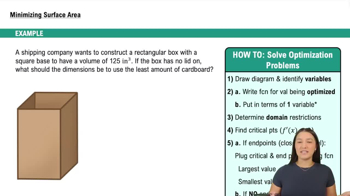Find the volume for a solid whose base is the region between the curve and the x-axis on the interval from and whose cross sections are equilateral triangles with bases parallel to the y-axis.
Table of contents
- 0. Functions7h 54m
- Introduction to Functions16m
- Piecewise Functions10m
- Properties of Functions9m
- Common Functions1h 8m
- Transformations5m
- Combining Functions27m
- Exponent rules32m
- Exponential Functions28m
- Logarithmic Functions24m
- Properties of Logarithms36m
- Exponential & Logarithmic Equations35m
- Introduction to Trigonometric Functions38m
- Graphs of Trigonometric Functions44m
- Trigonometric Identities47m
- Inverse Trigonometric Functions48m
- 1. Limits and Continuity2h 2m
- 2. Intro to Derivatives1h 33m
- 3. Techniques of Differentiation3h 18m
- 4. Applications of Derivatives2h 38m
- 5. Graphical Applications of Derivatives6h 2m
- 6. Derivatives of Inverse, Exponential, & Logarithmic Functions2h 37m
- 7. Antiderivatives & Indefinite Integrals1h 26m
- 8. Definite Integrals4h 44m
- 9. Graphical Applications of Integrals2h 27m
- 10. Physics Applications of Integrals 3h 16m
- 11. Integrals of Inverse, Exponential, & Logarithmic Functions2h 34m
- 12. Techniques of Integration7h 41m
- 13. Intro to Differential Equations2h 55m
- 14. Sequences & Series5h 36m
- 15. Power Series2h 19m
- 16. Parametric Equations & Polar Coordinates7h 58m
9. Graphical Applications of Integrals
Introduction to Volume & Disk Method
Problem 8.1.77
Textbook Question
Let f(x) = √(x + 1). Find the area of the surface generated when:
Region bounded by f(x) and the x-axis on [0, 1]
Revolved about the x-axis
 Verified step by step guidance
Verified step by step guidance1
Step 1: Recall the formula for the surface area of a solid of revolution about the x-axis: . Here, f(x) = √(x + 1), and the interval is [0, 1].
Step 2: Compute the derivative of f(x). Using the chain rule, . Simplify this to .
Step 3: Substitute f(x) and f'(x) into the surface area formula. The integrand becomes . Simplify the expression inside the square root.
Step 4: Simplify the term . This becomes . Combine terms under a common denominator if necessary.
Step 5: Set up the integral . Evaluate this integral using appropriate techniques, such as substitution or numerical methods, depending on the complexity of the integrand.
 Verified video answer for a similar problem:
Verified video answer for a similar problem:This video solution was recommended by our tutors as helpful for the problem above
Video duration:
6mPlay a video:
Was this helpful?
Key Concepts
Here are the essential concepts you must grasp in order to answer the question correctly.
Surface Area of Revolution
The surface area of revolution is calculated by rotating a curve around an axis. For a function f(x) revolved around the x-axis, the formula involves integrating the circumference of infinitesimally thin rings formed by the rotation. The formula is given by A = 2π ∫ f(x) √(1 + (f'(x))²) dx, where f'(x) is the derivative of f(x). This concept is essential for determining the area of the surface generated by the revolution.
Recommended video:

Example 1: Minimizing Surface Area
Definite Integral
A definite integral calculates the accumulation of quantities, such as area, over a specific interval [a, b]. In this context, it is used to find the area of the surface generated by revolving the function f(x) around the x-axis from x = 0 to x = 1. The definite integral provides a numerical value representing the total area, which is crucial for solving the problem.
Recommended video:

Definition of the Definite Integral
Derivative and Its Role
The derivative of a function, denoted as f'(x), represents the rate of change of the function with respect to x. In the context of finding the surface area of revolution, the derivative is used to compute the term √(1 + (f'(x))²), which accounts for the slope of the curve. Understanding how to find and apply derivatives is vital for accurately calculating the surface area.
Recommended video:

Derivatives

 5:38m
5:38mWatch next
Master Introduction to Cross Sections with a bite sized video explanation from Patrick
Start learningRelated Videos
Related Practice
Multiple Choice
125
views
3
rank
